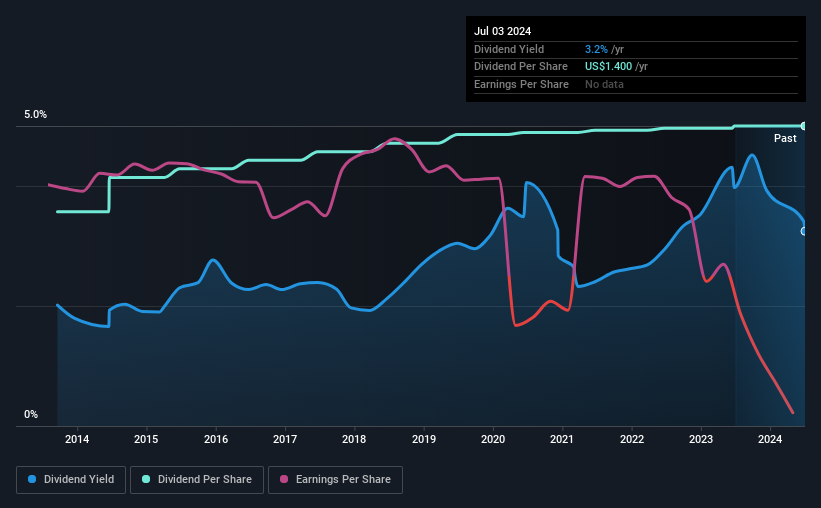Don't Buy John Wiley & Sons, Inc. (NYSE:WLY) For Its Next Dividend Without Doing These Checks
It looks like John Wiley & Sons, Inc. (NYSE:WLY) is about to go ex-dividend in the next four days. The ex-dividend date is one business day before the record date, which is the cut-off date for shareholders to be present on the company's books to be eligible for a dividend payment. The ex-dividend date is important because any transaction on a stock needs to have been settled before the record date in order to be eligible for a dividend. Thus, you can purchase John Wiley & Sons' shares before the 9th of July in order to receive the dividend, which the company will pay on the 25th of July.
The company's upcoming dividend is US$0.3525 a share, following on from the last 12 months, when the company distributed a total of US$1.40 per share to shareholders. Looking at the last 12 months of distributions, John Wiley & Sons has a trailing yield of approximately 3.2% on its current stock price of US$43.12. Dividends are a major contributor to investment returns for long term holders, but only if the dividend continues to be paid. As a result, readers should always check whether John Wiley & Sons has been able to grow its dividends, or if the dividend might be cut.
Check out our latest analysis for John Wiley & Sons
Dividends are usually paid out of company profits, so if a company pays out more than it earned then its dividend is usually at greater risk of being cut. John Wiley & Sons lost money last year, so the fact that it's paying a dividend is certainly disconcerting. There might be a good reason for this, but we'd want to look into it further before getting comfortable. With the recent loss, it's important to check if the business generated enough cash to pay its dividend. If John Wiley & Sons didn't generate enough cash to pay the dividend, then it must have either paid from cash in the bank or by borrowing money, neither of which is sustainable in the long term. It paid out more than half (73%) of its free cash flow in the past year, which is within an average range for most companies.
Click here to see how much of its profit John Wiley & Sons paid out over the last 12 months.
Have Earnings And Dividends Been Growing?
Companies with falling earnings are riskier for dividend shareholders. If earnings fall far enough, the company could be forced to cut its dividend. John Wiley & Sons was unprofitable last year and, unfortunately, the general trend suggests its earnings have been in decline over the last five years, making us wonder if the dividend is sustainable at all.
Many investors will assess a company's dividend performance by evaluating how much the dividend payments have changed over time. In the past 10 years, John Wiley & Sons has increased its dividend at approximately 3.4% a year on average.
Remember, you can always get a snapshot of John Wiley & Sons's financial health, by checking our visualisation of its financial health, here.
Final Takeaway
Is John Wiley & Sons worth buying for its dividend? First, it's not great to see the company paying a dividend despite being loss-making over the last year. On the plus side, the dividend was covered by free cash flow." Bottom line: John Wiley & Sons has some unfortunate characteristics that we think could lead to sub-optimal outcomes for dividend investors.
Although, if you're still interested in John Wiley & Sons and want to know more, you'll find it very useful to know what risks this stock faces. For example - John Wiley & Sons has 3 warning signs we think you should be aware of.
If you're in the market for strong dividend payers, we recommend checking our selection of top dividend stocks.
Have feedback on this article? Concerned about the content? Get in touch with us directly. Alternatively, email editorial-team (at) simplywallst.com.
This article by Simply Wall St is general in nature. We provide commentary based on historical data and analyst forecasts only using an unbiased methodology and our articles are not intended to be financial advice. It does not constitute a recommendation to buy or sell any stock, and does not take account of your objectives, or your financial situation. We aim to bring you long-term focused analysis driven by fundamental data. Note that our analysis may not factor in the latest price-sensitive company announcements or qualitative material. Simply Wall St has no position in any stocks mentioned.
Have feedback on this article? Concerned about the content? Get in touch with us directly. Alternatively, email editorial-team@simplywallst.com

 Yahoo Finance
Yahoo Finance 
